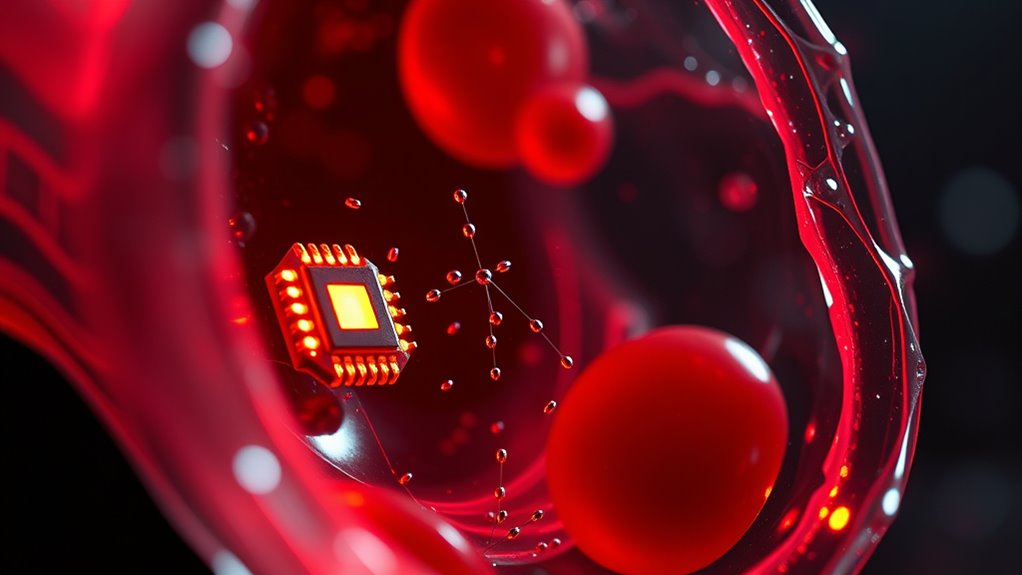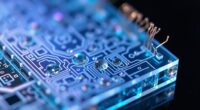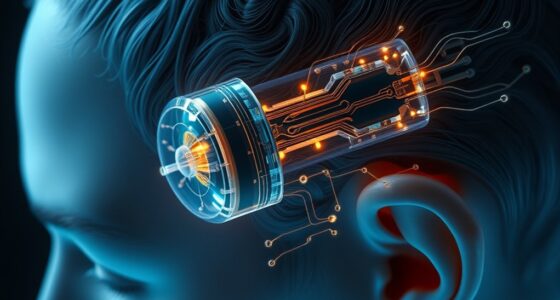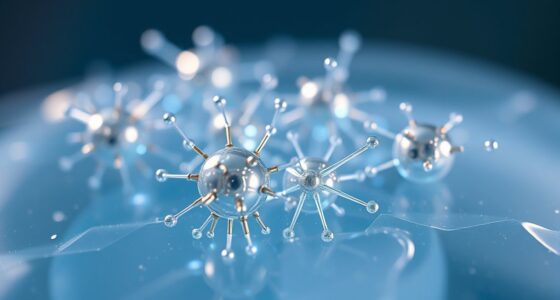Nanotech is transforming blood diagnostics by providing faster, more accurate, and highly sensitive detection of disease markers. With nanoscale sensors, you can identify proteins, nucleic acids, or small molecules even in tiny blood samples, often within minutes. These technologies also allow for multiplexed testing, giving a complete health profile from a single sample. As this field advances, it promises to make healthcare more accessible, personalized, and efficient—so stay tuned to discover how these innovations will shape the future.
Key Takeaways
- Nanotech sensors enable rapid, highly sensitive detection of blood biomarkers at cellular and molecular levels.
- They support early diagnosis by identifying disease markers before symptoms appear.
- Nanotechnology allows multiplexed testing, providing comprehensive health profiles from a single blood sample.
- These advances improve diagnostic accuracy, reduce false results, and facilitate personalized treatment plans.
- Nanotech integration into portable devices enhances point-of-care testing, expanding healthcare access worldwide.

Nanotechnology is transforming blood diagnostics by enabling highly precise and rapid detection of diseases at the cellular and molecular levels. With advancements in nanotech sensors, you now have tools that can identify even the tiniest traces of biomarkers associated with various health conditions. These sensors are engineered at the nanoscale, allowing them to interact intimately with biological molecules, which results in highly sensitive and specific detection capabilities. As a result, blood analysis techniques have evolved from traditional, time-consuming methods to faster, more accurate processes that can provide real-time insights into your health status.
Nanotech blood diagnostics enable rapid, precise detection of diseases at the cellular level.
When you utilize nanotech sensors in blood diagnostics, you’re leveraging their ability to detect minute concentrations of disease indicators, such as proteins, nucleic acids, or small molecules. Unlike conventional methods that may require large sample volumes and lengthy processing times, these sensors can work with tiny blood samples and deliver results within minutes. This rapid turnaround is particularly essential for early diagnosis, where timely intervention can greatly improve outcomes. Furthermore, nanotech sensors can be integrated into portable devices, making point-of-care testing feasible. This means you could potentially get immediate results during a routine check-up or in remote settings where access to advanced laboratories is limited.
Blood analysis techniques powered by nanotechnology also improve the accuracy of diagnostics. Because of their high surface area-to-volume ratio and customizable surface properties, nanomaterials can be tailored to target specific biomarkers with exceptional precision. This specificity reduces false positives and negatives, giving you greater confidence in the test results. Additionally, the enhanced sensitivity of nanotech sensors allows for the detection of disease markers at very early stages, often before symptoms manifest. Early detection is essential because it opens the door to more effective interventions and personalized treatment plans. Incorporating crochet styles for locs and other protective strategies can also help maintain the integrity of your hair while undergoing medical procedures or long-term treatments.
Furthermore, these innovative blood analysis techniques facilitate multiplexing—simultaneously testing for multiple conditions in a single sample. Imagine getting a comprehensive health profile from a single drop of blood in just a few minutes. This capability not only saves time but also provides a broader understanding of your health, enabling more accurate diagnoses and better management of chronic diseases. The ongoing development of nanotech-enhanced blood diagnostics is paving the way for more accessible, faster, and precise healthcare solutions. As these technologies become more widespread, you’ll likely find yourself benefiting from early detection, personalized treatments, and improved health outcomes that were once out of reach with traditional blood analysis methods.
Frequently Asked Questions
How Does Nanotech Improve Early Disease Detection?
Nanotech improves early disease detection by enabling molecular precision, allowing you to identify tiny amounts of early biomarkers with high accuracy. It targets specific molecules associated with diseases, making it possible to detect conditions long before symptoms appear. This technology enhances sensitivity and speed, giving you faster, more reliable diagnoses. As a result, you can start treatment sooner, potentially improving outcomes and saving lives through earlier intervention.
Are Nanotech Blood Tests Cost-Effective for Widespread Use?
You might wonder if nanotech blood tests are truly cost-effective for widespread use. The answer hinges on a careful cost analysis that weighs their higher initial expenses against long-term savings through earlier diagnosis. Insurance coverage plays a key role, potentially making these advanced tests more accessible. While costs are still being evaluated, ongoing developments suggest that, with the right support, nanotech tests could become a practical, valuable tool for healthcare everywhere.
What Are Potential Risks of Nanotech in Blood Diagnostics?
You should be aware that nanotech in blood diagnostics presents potential risks, including ethical concerns like privacy issues and consent, and environmental impacts from nanoparticle disposal. These technologies could lead to unintended biological effects or contamination if not properly managed. It’s essential to thoroughly assess these risks to guarantee safe, responsible use, and to develop regulations that protect both individuals and the environment.
How Long Does It Take to Develop New Nanotech Diagnostic Tools?
It typically takes several years to develop new nanotech diagnostic tools, mainly due to regulatory hurdles and manufacturing scalability challenges. You’ll need to navigate rigorous testing and approval processes, which can delay progress. Scaling up production also requires significant investment and testing to verify consistency. While the timeline varies depending on complexity, expect a development period of around 5-10 years from initial research to market-ready devices.
Can Nanotech Diagnostics Be Used at Home?
Yes, nanotech diagnostics can be used at home, making testing more accessible and convenient. With advancements in technology, these tools are becoming user-friendly, allowing you to perform tests without visiting a lab. Home testing with nanotech devices offers quick results and improved user accessibility, empowering you to monitor your health more easily. As these tools evolve, expect even more straightforward, reliable options for at-home diagnostics in the future.
Conclusion
As you explore the potential of nanotech in blood diagnostics, one thing becomes clear: we’re on the cusp of a revolution in healthcare. With each breakthrough, the future of early detection and personalized medicine grows closer. But what undiscovered possibilities lie ahead? The next chapter remains unwritten, and only time will reveal how this tiny technology will reshape your understanding of health—and perhaps, even save lives you never knew needed saving.









